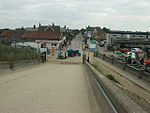Calthorpe Broad
National nature reserves in EnglandNature Conservation Review sitesNorfolk BroadsRamsar sites in EnglandSites of Special Scientific Interest in Norfolk ... and 2 more
Special Areas of Conservation in EnglandSpecial Protection Areas in England

Calthorpe Broad is a 43.5-hectare (107-acre) biological Site of Special Scientific Interest east of Stalham in Norfolk. It is a Nature Conservation Review site, Grade I and a national nature reserve. It is also part of the Broadland Ramsar site and Special Protection Area, and The Broads Special Area of Conservation.This broad has diverse fauna and flora. Water plants include mare's-tail, water violet, blunt-leaved pondweed, spiked water-milfoil, floating scirpus, yellow water-lily and the nationally scarce water soldier.The site is private land with no public access.
Excerpt from the Wikipedia article Calthorpe Broad (License: CC BY-SA 3.0, Authors, Images).Calthorpe Broad
Sea Palling Road, North Norfolk Ingham
Geographical coordinates (GPS) Address Nearby Places Show on map
Geographical coordinates (GPS)
| Latitude | Longitude |
|---|---|
| N 52.777 ° | E 1.573 ° |
Address
Sea Palling Road
NR12 0TP North Norfolk, Ingham
England, United Kingdom
Open on Google Maps









